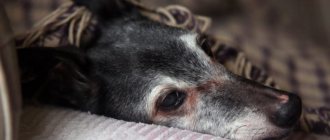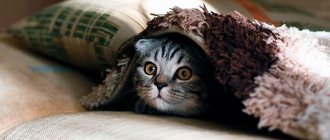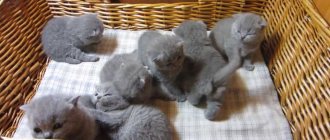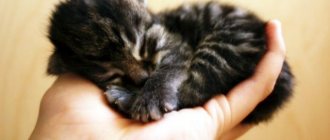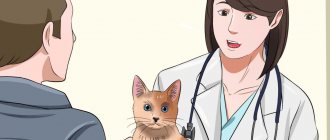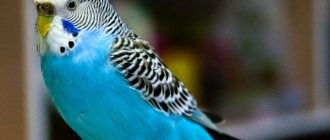What to do if a cat sheds a lot - even experienced breeders can face this problem. The normal process of molting in a healthy animal occurs every spring and autumn. This is how your pet’s body prepares for either the summer heat or the winter cold.
However, in some cases, shedding occurs in the off-season or does not stop for a long time. This symptom should alert any responsible owner.
What periods are considered normal for molting in terms of time of year and duration?
Seasonal coat change is a natural phenomenon that should not bother owners.
Cats shed their hair from time to time. The first hair change is called juvenile. A teenager changes his child's coat to an adult's one at six months of age, sometimes a little earlier or later.
Mature cats shed twice a year: in spring and autumn. This is how animals protect themselves from summer heat and winter frosts. This molting is called seasonal, or physiological.
The hair change process takes up to nine weeks. Shedding usually does not cause problems in pets of short-haired breeds.
Long-haired cats need help from their owners. If you do not comb out the hair that falls out, tangles form, within which ideal conditions are created for the reproduction of ectoparasites.
Features of shedding of some breeds
How a cat sheds is largely determined by its breed. The amount of hair left behind by a shedding cat is affected not only by the length of its coat (guard hair), but also by the density and length of the undercoat.
If we consider cat breeds according to the intensity of shedding, they can be divided into:
- highly shedding cats with a lot of undercoat: Persian and Himalayan cats;
- Maine Coon;
- British cat;
- Angora cat;
- Siamese cat;
- sphinxes - depending on the variety, hair may be completely absent or its length may be no more than 2 mm;
Shedding in sphinxes is minimal due to the almost complete absence of hair.
Causes of severe shedding
Long-term intense hair loss is called pathological shedding.
It occurs for the following reasons:
- congenital anomalies;
- unbalanced diet;
- frequent bathing;
- stress;
- allergy;
- drug dermatitis;
- hormonal disorders;
- infectious diseases;
- oncology.
Congenital pathologies
With a genetic abnormality called hypotrichosis, the kitten's hair begins to fall out rapidly. By eighteen weeks the pet is completely hairless and remains that way for the rest of its life.
Also, a kitten may have a genetic predisposition to seborrhea or adenitis - hypersecretion of the sebaceous glands. An additional sign of the presence of one of these diseases is an unpleasant odor from your pet’s skin.
Be sure to read:
Bald spots in cats: causes of baldness on the back, head, paws and ears
Unbalanced diet
Each cat has different nutritional needs. Some pets are not suitable for ready-made food, while others are not suitable for natural food. First, the fur stops shining, then it becomes disheveled and begins to fall out.
Sometimes the cause of deficiency is a changed physiological state.
A lactating female requires a diet richer in healthy components. Nutrients are primarily used to maintain vital functions and synthesize milk. The hair does not receive enough of it and therefore dies.
Not only a deficiency, but also an excess of nutrients has an adverse effect. Thoughtless use of vitamin supplements leads to poisoning. The body gets rid of toxic metabolites through diarrhea, vomiting, increased urination and shedding hair.
Frequent bathing
Cats can, but don't like to swim. They don't need bathing. Often overly caring housewives regularly wash their pussy. The shampoo degreases the hairs, they lose their protective layer, become brittle, and fall out.
Stress
A change of environment, a long journey, fear, jealousy, or a sudden change in diet can cause an inadequate reaction. The cat develops baldness in certain areas, sometimes half of the body.
Allergy
Hair loss is a side effect of medication.
Your pet may have an allergic reaction to:
- feed components, such as chicken or cereal proteins;
- odors, perfumes, tobacco smoke, pollen, fungal spores - atopic dermatitis;
- household chemicals, accessories, flea collars - contact dermatitis.
Additional symptoms of allergies are rashes, crusts and ulcers.
Drug dermatitis
Hair loss is a side effect of medication use. The course of treatment is interrupted and the drug is replaced.
Hormonal disorders
The main cause of hormonal disorders is diseases of the endocrine glands or regular use of contraceptives: Contrasex, Anti-meow, etc.
Contagious diseases
Hair loss in most cases is accompanied by a violation of the integrity of the skin.
It is provoked by the following diseases:
- lichen - a fungal infection of the skin;
- flea dermatitis;
- notoedrosis, demodicosis - lesions by intradermal mites;
- helminthiasis - infection by parasites.
Be sure to read:
What to do if a cat licks its fur to bald spots and wounds, what is overgrooming
Oncology
Cancer affects all life support systems, including hair follicles. The onset of tumor formation usually coincides with the aging of the cat.
Useful video
Watch this video on how to properly comb a cat:
Similar articles
- How to wash a cat if he is afraid, how to do it...
in case of severe shedding in order to prevent the development of hairballs in... And here is more about why a cat has bad breath. Bathing products. Read more - Why does my cat's hair fall out and come out in clumps...
The reasons why a cat's hair will fall out are very diverse - from physiological molting to serious infectious diseases. Read more
- How to trim a cat's hair at home: shave it yourself...
A cat has a prolapsed uterus: what to do? ... With prolonged molting, such a hairdressing procedure can make it easier to maintain a pet. Read more
- Why does a cat drool from its mouth: causes and treatment
Any owner should understand that if a cat is drooling from its mouth, this is a physiologically abnormal phenomenon, there is always a reason... Read more
- What happens if you cut a cat's whiskers, trim them...
Diabetes mellitus was discovered in a cat: why it occurred, how to treat and feed it... ...And here is more information about what to do if your cat sheds a lot. Read more
Ways to reduce shedding
To reduce the intensity of hair loss, the root cause is eliminated. Cats suffering from seborrhea and adenitis are treated during exacerbations with external means - aerosols or ointments, which are prescribed by a veterinarian.
Hair loss from a lack of nutritional components is observed when feeding natural food, ready-made economy-class food. Some foods are not suitable for animals. Your veterinarian can advise you on which foods or supplements to use and which to avoid.
Sometimes hair loss stops if you stop bathing your pet frequently. When stressed, the fur grows back when the animal calms down. To do this, you need to play with your pet, pay attention to it, and pet it. They also use sedatives: Kot Bayun, Stop-stress, Feliway.
To treat infectious diseases, hormonal disorders, oncology and side effects of drugs, they seek veterinary help.
Long-haired pets are periodically combed.
Furminator for hair care
To help your cat renew its coat faster and get rid of tangles, it is best to use a special device. The Furminator is perfect for long-haired cats. Initially, the word was the name of the trademark of one American company, which developed the device. Now this is the name given to all manual “combers” that combine the functions of a slicker, comb and trimmer.
A cat's fur is not like human hair. Several hairs grow from one follicle at once: central; 2–3 additional, undercoat and down. In order for the animal to look beautiful and neat, the old fur must be removed. Otherwise, your cat will shed all year round.
Regular combs are not able to process the undercoat; special combs damage the top layer of skin. The Furminator for long-haired cats does not have all these disadvantages. Outwardly, it is similar to a razor, but instead of a traditional blade, it has a special metal comb with sharpened teeth. With its help it is very easy to process the undercoat and remove dead hairs. Living hairs remain intact.
How to relieve a cat's condition
Hypotrichosis is incurable. The animal will constantly freeze. Therefore, it is necessary to maintain an optimal air temperature in the apartment - 22-24 °C. If the owners decide to walk the cat in cool weather, they will have to dress it.
Long-haired pets are periodically combed.
In long-haired pets, in addition to excessive shedding, intestinal blockage may occur with trichobezoars - stones formed from a mixture of hairs swallowed while licking and the contents of the alimentary tract.
If the cat owner does not use special super-premium food, you will have to periodically give Malt paste, which prevents hair from clumping.
To speed up molting, special feed additives are used:
- Laveta Super from Beafar;
- Sherstevit;
- Gimpet.
Products based on brewer's or feed yeast reduce the duration of shedding. Caring for a shedding pet involves frequently combing out lost hair.
In advanced situations, the crumpled wool is removed using tangle cutters. If the cause of hair loss is a contagious disease, you must follow the instructions of your veterinarian.
Be sure to read:
A cat's hair is falling out: reasons, what to do during shedding, treatment of baldness, approved medications
Actions in case of pathological condition
In the event that intense hair loss does not depend on external factors such as hygienic care and living conditions, the owner should look for the cause in the health of the pet. To do this, you should take the following steps:
- Visit a veterinarian and rule out diseases of internal organs, allergies and other pathologies. If any disease is detected, it is necessary to carry out a course of treatment, after which the phenomenon of molting will also decrease.
- When the cause of the phenomenon is an unbalanced diet , then understanding what to do if the cat sheds heavily is quite simple in this case: you should review the animal’s diet and make adjustments to it. If your cat prefers dry food, you should switch her to premium products designed to improve the condition of her coat.
- If the cause of this phenomenon is determined by a specialist to be a hormonal imbalance in an unsterilized cat, then the question of sterilization should be considered.
- Taking special vitamin complexes that reduce molting . Before purchasing them, you should consult a veterinarian and do not use more than the course indicated by your doctor.
If the cause of molting is any external factors, you can eliminate them yourself. Proper hair care, combing, washing with special shampoos, and the use of indoor air humidifiers alleviate the cat's condition. For more serious reasons (poor diet, stress, diseases of internal organs, allergies), the owner should seek help from a veterinarian.
Vitamins for cats
Cat owners have a choice: give imported complete food of premium class and higher or use natural food. In the first case, vitamins are not needed. They are included in the finished dry food in the required quantities and optimal ratio.
If the owner uses an unbalanced diet, the pet may develop problems with its coat. The problem is eliminated with the help of complex vitamin and mineral supplements.
Cat lovers prefer to use the following drugs:
- Felvit Multi;
- Kitty's +Taurine-Biotine;
- Gimpet Katzentabs;
- Laveta Super;
- Kitty's +Taurine-Biotine/Proteine/Cheese (vitamin mixture for cats);
- vitamins Doctor ZOO.
What to do if your cat sheds a lot
There are many reasons why a cat sheds. Therefore, the first decision after thinking about “what to do to prevent your cat from shedding” should be a trip to the veterinarian.
Only a doctor can determine why a cat often sheds and find a solution to this problem. But with excellent health and regular preventive examinations, the problem can be solved on your own.
Creating a suitable temperature regime
While creating an ideal atmosphere with a pleasant temperature in the apartment, people often forget that a pet may be uncomfortable in such conditions. It is advisable to give the cat at least a symbolic change of seasons.
If a cat sheds a lot, this is one of the many problems with which pet owners turn to the veterinarian. One of the simplest and fastest solutions to the problem would be to provide the animal with a place on the balcony, since it is in this room that the temperature is closest to the outside temperature. Of course, it is necessary to equip your pet with a cozy house and take care of her complete safety.
Combing
The first thing you need to do to prevent your cat from shedding is to brush him. As a rule, even a simple slicker from a pet store will be enough, but for pets with long and thick hair, if possible, you should purchase a furminator.
This device is more convenient because it reaches the deep layers of fur; its use will quickly rid the animal of falling hairs.
Accustoming an animal to combing should begin at a young age. This way you can avoid stress, but many adult cats are calm about the brush as long as you don’t cause them unnecessary discomfort.
Vitamin and mineral complexes
If your cat sheds a lot, you should pay attention to his diet. In conditions where an animal is kept in an apartment, the lack of nutrients will be especially catastrophic.
Therefore, if possible, you should purchase animal food that contains enough different vitamins and minerals. In veterinary pharmacies you can also purchase vitamin and mineral complexes for the beauty and health of the coat, which must be given to your pet with natural nutrition.
Before introducing any supplements into your diet, you should consult with a specialist.
Preventing Excessive Shedding
To keep your pet healthy and its fur not decorating your trousers, carefully monitor its diet:
- do not give your animal harmful foods: spicy, smoked, salty or fried foods;
- if you use ready-made food, purchase only a high-quality product from a well-known brand;
- include a sufficient amount of vitamins and microelements in your diet;
- do not overfeed your pet, especially if it is not young;
- Take your cat to the veterinarian regularly and do not neglect the required vaccinations.
Even if your cat has never been outside, this does not mean that she cannot get sick. We bring a variety of infections home ourselves, on clothes and shoes.
Allergy
The cause of excessive shedding in cats can also be an allergic reaction to unsuitable care products - shampoos, lotions, conditioners, hard brushes, too hot water when bathing or a hair dryer jet (allergy to mechanical effects on the skin).
© shutterstock
If cosmetics and care products are used incorrectly or inappropriately, dandruff and irritation appear on the scalp, and hair begins to fall out. Cats have much more sensitive and thinner skin than humans! Change your shampoo, be more careful with your slicker brush and hair dryer, buy cat vitamins “for fur” that help strengthen and nourish the skin and hair follicles. This will not only help stop your cat's shedding, but will also keep her healthy.
Allergies can manifest not only to household chemicals, but also to flowering plants, insect bites, dust, medications, food, etc. In this case, sneezing, saliva-and-tear-flow is not at all necessary, but scratching, dandruff and profuse hair loss are required.
Seeing a doctor is also mandatory! Only he, through testing, will be able to determine the allergen affecting the cat and prescribe the necessary medications.
